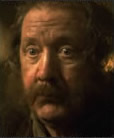On those who stayed in Middle-earth
“But many refused the summons, preferring the starlight and the wide spaces of Middle-Earth to the rumor of the Trees; and these are the Avari, the Unwilling, and they were sundered in that time from the Eldar, and met never again until many ages were past.” (The Silmarillion)
The Avari were those elves who never took the westward journey to Aman. They stayed near Lake Cuiviénen, somewhere far to the east. I’ve always wondered if the Sea of Rhûn is really Cuiviénen, but there’s no way to tell.
The groups that hesitated or stayed behind were:
~ The Avari – those who refused to follow the Valar. We don’t really hear what happened to them, but maybe they spread out and joined the wood-elves.
~ The Teleri, those who hesitated. They included:
… The Teleri of Aman, who followed Elwë/Thingol but gave up waiting for him and sailed to Aman.
… The Sindar of Doriath, who intended to go to Aman, but decided to stay with Thingol. They were considered “blessed” because of the power of Thingol’s queen Melian.
… The Nandor. These were originally Avari, and refused to follow the Valar west. However, an Avari named Denethor led some of his elves west— not to find Aman, but to to find his lost kin. Some Nandor settled around Mirkwood and Lórien and are called Wood-elves. Others went on to Ossiriand and were called Green-Elves.
The Sindar and Nandor and Avari are also known as the Dark Elves, or Moriquendi.
The Nandor
The Nandor, both the Wood-elves and Green-elves, were a primitive forest people who didn’t care about lore or metal-smithing. They didn’t wear armor, and fought with bows by stealth, hiding in the trees. They avoided the “civilization” of the elf kingdoms.
The Sindar
The Sindar became wise and had a great civilization. At the end of the First Age, some Sindar finally sailed west to Aman. Others went back east to settle in Lindon/Lune, or in Eregion with the surviving Noldor. By the Second Age, the Noldor and the Sindar were pretty well fused together. After the fall of Beleriand, some of the Green-elves joined those elves, and others went east over the Misty Mountains to rejoin the Silvan elves.
A few Sindar families decided that most of the elves’ troubles stemmed from their dealings with the Valar, and decided it would be best to return to the primitive, simple lifestyle of the elves that never went into Beleriand or Aman. These “renunciates” went east of the Misty Mountains and founded some kingdoms among their long-lost Nandor kin, the Silvan / Wood-elves. These Sindar princes tried to live like the Silvan Elves, and they included Legolas’ family and the family of King Amroth of Lórien.
Legolas’ family really went back to nature. Legolas calls himself a Wood-elf, and the Mirkwood Elves pretty much broke contact with Lórien after Amroth died and Galadriel and Celeborn took over.
The Silvan Elves of Lórien weren’t quite so isolationist. They welcomed the Sindar and Noldor of Eregion, who visited them through Moria or the Redhorn Pass. They also kept contact with the elves west of the Misty Mountains.
Later history
We don’t really know much about what happened after the end of the Third Age. In the forward to FotR, it says:
“There [Rivendell], though Elrond had departed, his sons long remained, together with some of the High-elven folk. It is said that Celeborn went to dwell there after the departure of Galadriel; but there is no record of the day when at last he sought the Grey Havens, and with him went the last living memory of the Elder Days on Middle Earth.”
That means that all the Noldor and Sindar eventually sailed to Aman.
Galadriel tells Frodo that after the ring is destroyed,
“We must depart into the West, or dwindle to a rustic folk of dell and cave, slowly to forget and to be forgotten.”
And that’s probably what happened to the majority of the Wood-elves and Green-elves. Some probably sailed west, but most are likely to have stayed in Middle Earth. Ironically, Legolas’ father, who was pretty much the least important Elvenking ever, eventually became the last Elvenking in Middle Earth, and would have held power as they faded away.
It’s notable that the description of the “rustic folk” matches Tolkien’s original, very early concept of gnomes, fairies, and pixie-like elves which he gradually changed and ennobled while inventing and fleshing out Middle Earth. His earliest writings resemble Victorian fairy tales and George MacDonald: Melian is a Fairy Queen, and the elves are almost whimsical little nature spirits. During the course of developing Middle Earth, he made them grander, powerful, greater rather than lesser than men. But it sounds like the fate of the Wood-elves was to return to the cradle, so to speak, and become the fairies and sprites of popular British mythology.
Research by Sepdet









